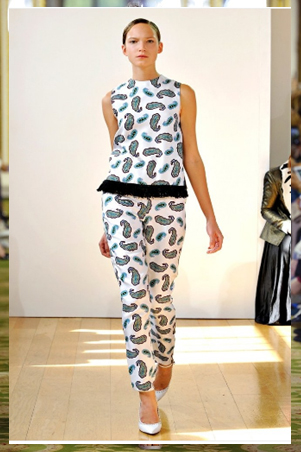Such an explosion of fashion talent blew up in London in the 2010s that people are always asking me: Why? How did an underdog fashion city, which so many quit as a show capital in the 2000s—Alexander McQueen, Stella McCartney, and John Galliano included—turn into a creative hotbed for young entrepreneurs? The short answers are these: It was British fashion education (which prioritizes individuality and innovation), London’s multicultural welcome to all (now threatened by Brexit), and the digital revolution that came along to make even tiny shows internationally visible. More than anything, though, it’s the fact that a whole community wanted to come together and make it happen.
Looking back it seems incredible that Jonathan Anderson—today’s lodestar of Paris, groundbreaker in the new fashion-as-craft movement at Loewe—was a boy who only started his JW Anderson label in London in 2010. He was in the unheated basement of a ramshackle industrial building in Shackle well Lane at the time. Not long after, I found Simone Rocha, a 2010 graduate of Central Saint Martin’s M.A., in a tiny room upstairs, with her lace dresses festooned everywhere and thickets of dried flowers hanging from the ceiling; she was preparing to make her first Dover Street Market window at the personal invitation of Rei Kawakubo, she explained.

Across the road Christopher Kane and his sister Tammy were working in another redbrick post-industrial edifice, coming up with a collection of neon lace and laser-cut leather they called “Princess Margaret on Acid” (Spring 2011) and many more that would astonish with his unpredictable synapse leaps. The multilayered pink chiffon dress Kane made to look like the leaves of an open book (Fall 2014) ended up in the very grand library at Chatsworth House as part of Laura Burlington’s House Style exhibition in 2017.

The year 2010 was also the beginning for Mary Katrantzou and her plunge into the surreal depths and heights of digital printing. She was sleeping under her desk, surrounded by skirts made in the shape of lampshades and fancy trompe l’oeil printed dresses, and working on her breakthrough Spring 2011 collection when I visited her. Katrantzou’s walk-in wardrobe-size studio was in the same Centre for Fashion Enterprise space that Erdem Moralioglu had sprung from with his gloriously feminine dresses a few years earlier. He was completely clear about what he wanted. “We may be in the East End,” he trilled, “but let’s pretend we’re in Paris!!
Because the Londoners were getting reviewed by style.com (my job before Vogue Runway replaced it), it meant that the new guard could be seen and read about on the same platform as Prada, Chanel, Versace, or anyone. That liberated a whole generation (not just Londoners) to start flexing and communicating in new and different ways. There was no point in schlepping to show in Paris, Milan, or New York, with all the attendant expenses, when your home city was already able to grab global attention.
Christopher Bailey and Burberry gave a huge boost to British fashion culture when the show was repatriated to London from Milan in 2009. A huge element in the big brand return was Bailey’s excitement about running with new technologies—Burberry shows were live streamed, tweeted, Instagrammed, and hash tagged way ahead of any other major brand’s capability. In Fall 2010, right at the beginning of the decade, Bailey had us all on the edge of our seats in a huge marquee pitched right opposite his alma mater, the Royal College of Art, as the first luxury see-now, buy-now section of the collection (some memorably hefty shearling flying jackets and trench hybrids) went live to a global audience. It seemed even closer to home for Bailey when he also disrupted the system by showing Burberry menswear in London, a lovely collection celebrating the English eccentricity of the colourful ways David Hockney and Alan Bennett dressed (Spring 2014).
The thing about British design education is that it’s based on an art school template that encourages self-expression, allied with historical and cultural research—imitating what’s already on the market is academic and social death. This yardstick for what’s regarded as good—and relevant—is held high by peers and educators alike. Personal honesty (you must have the conviction to say what you like), soaring imagination, and skill are applauded above all. That culture created the conditions for Meadham Kirchhoff to be revered. Here were two edgy young London designers who conjured beautiful fantasias, strange travellers, witches, and, once, an incredible incarnation of Marie Antoinette, bedecked in black velvet, gold-embroidered rococo jacket laced with fat satin ribbons and bows (Spring 2013).
Edward Meadham and Benjamin Kirchhoff went under, but that did not erase the significance of their contribution to London culture. The Marie Antoinette jacket was immortalized in a portrait painted by Ben Ashton of the London underground doyenne Princess Julia, which is now available in postcard form as a souvenir of the National Portrait Gallery.
This is another crosscurrent that powered the creative surge in Britain in the 2010s: the fact that lofty establishments—art institutions and even royalty—started to embrace young fashion designers. The years 2010 and 2011 were off the scale for British optimism and presenting a friendly young face to the world. Sarah Burton’s secret workings on Catherine Middleton’s wedding dress in 2011 (between the McQueen studio and Kensington Palace) were camouflaged by the designer’s glorious double bluff of a fall 2011 white snow queen Alexander McQueen collection.
The London Olympics in 2012, coinciding with the Diamond Jubilee of Elizabeth II (marking the 60th anniversary of her accession), seems in retrospect to have brought out the best in everyone. After her show inspired by flowers—especially a couple of ornately sculptural pink dresses based on carnations—Sarah Burton said she was thinking of “a beautiful future, positivity, optimism.”



















Enquiry